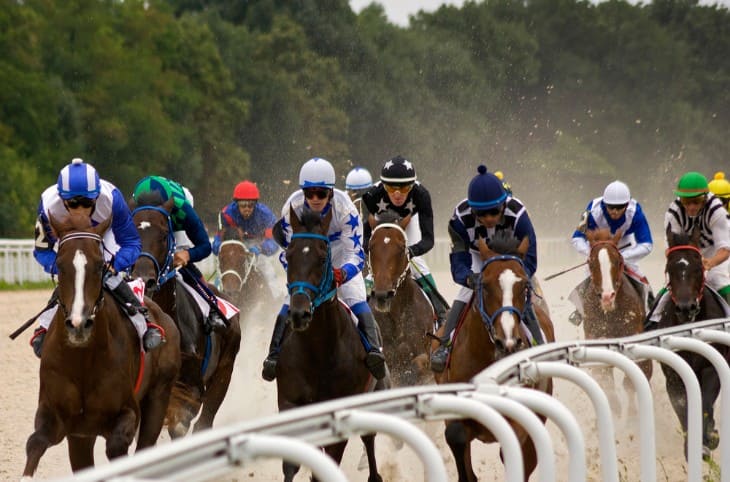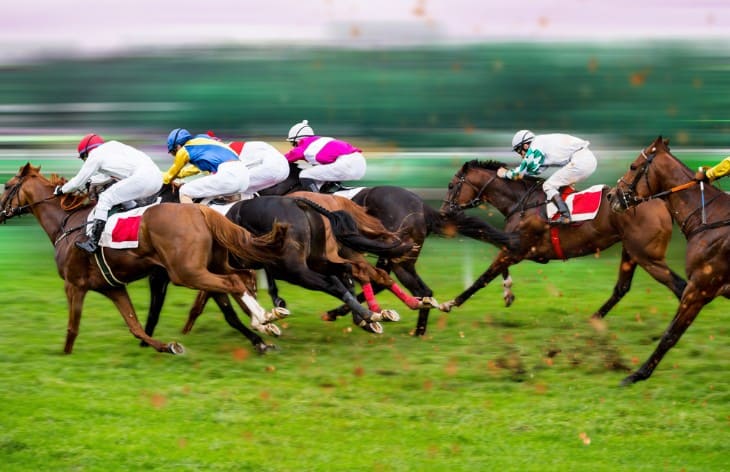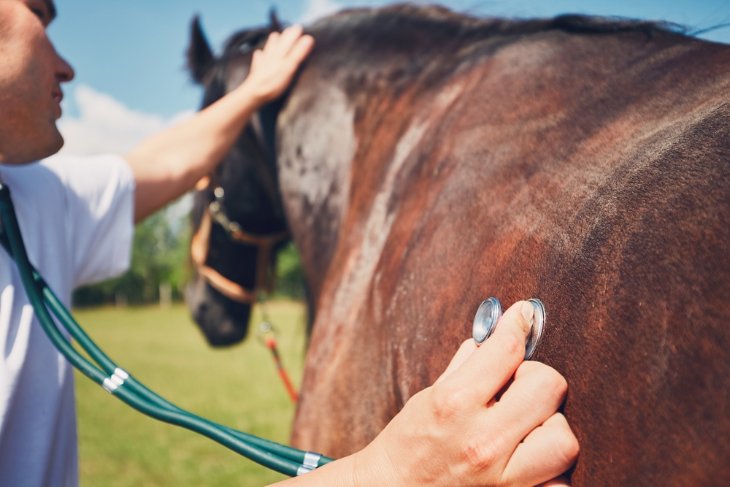Understanding the Anatomy of Racehorses
A racehorse's success is based upon a delicate balance between form and function. The study of the anatomy of racehorses provides us with insights into the interconnected systems that enable these athletes to achieve their remarkable feats on the racetrack. From the rhythmic gallop propelled by powerful hindquarters to the efficient pumping of blood by a strong heart, every element plays a vital role in the racehorse's performance.
The anatomical structure of a racehorse, especially its strong legs and complex hooves, is specifically evolved to endure the high stresses of racing at top speeds. As we examine the horse's skeleton and the mechanics of its movement, it becomes clear how veterinarians focus on maintaining skeletal health and preventing injuries.
Internally, the horse's circulatory and respiratory systems work in tandem to provide essential oxygen and nutrients to its muscles during a race. The horse's heart is particularly efficient, powering the extreme physical activity required on the racetrack. A deeper understanding of these systems highlights the veterinary challenges involved in ensuring maximum oxygen supply and optimal performance.

A Vet's Toolkit: Diagnostic Techniques in Racehorse Medicine
On the racetrack, veterinarians play an indispensable role in maintaining the health of elite racehorses. Using state-of-the-art diagnostic equipment, they diagnose a range of conditions, from minor gait issues to serious internal problems, demonstrating the progress in equine medical science.
Critical to their work is the ability to observe horses closely to detect signs of discomfort or abnormal movement. Small details like a minor muscle twitch or a change in stride can provide initial clues for diagnosis.
To aid in their assessments, veterinarians use advanced imaging technologies. Ultrasonography gives them a detailed view of the horse's internal structures like tendons, ligaments, and organs. Radiography is useful for examining bones and joints, helping to identify fractures or signs of wear and tear.
Blood, urine, and other fluid tests are also conducted to gain a complete picture of the horse's health. These tests can reveal issues like metabolic imbalances or signs of inflammation, providing a comprehensive understanding of the horse's physical condition.
Another important diagnostic tool is lameness evaluation. Veterinarians use manual palpation, flexion tests, and assessments of the horse's gait to look for abnormalities that could indicate a problem. These evaluations are essential for creating effective treatment plans and ensuring that horses are able to compete at their best.
In summary, the work of a racehorse veterinarian involves a mix of keen observation and advanced scientific techniques. Their goal is to detect both obvious and subtle health issues, thereby ensuring the well-being and peak performance of these specialized athletes.
From Foal to Finish Line: Managing Racehorse Health and Development
The process of developing a foal into a fully-grown racehorse involves careful oversight at every stage. Veterinarians are crucial in ensuring that each phase of growth and training is handled with meticulous attention. Starting from the moment of birth until the horse's first race, their medical expertise contributes significantly to the animal's well-being and potential success.
In the initial stages, neonatal care is critical. Veterinarians are responsible for monitoring the foal's health, treating any medical challenges, and making sure that proper nourishment is provided. As the horse grows, the veterinarian works closely with trainers and other staff to lay a strong foundation for physical and mental health. This involves regular check-ups, vaccinations, and consultations on diet and training, setting the stage for a healthy and successful racing career.
Nutrition and care, takes center stage in the development journey. Balancing the dietary needs of a growing racehorse requires precision and insight, with veterinarians tailoring feed and supplements to support optimal bone, muscle, and joint development. As the horse's training intensifies, nutritional adjustments become pivotal in maintaining performance and preventing injuries.
Strides of Strength: Preventing and Treating Musculoskeletal Injuries
In the competitive field of horse racing, the musculoskeletal system plays a crucial role in a horse's performance. Veterinarians specializing in racehorses focus on preventing and treating injuries to muscles, tendons, and ligaments, which are highly susceptible to stress and strain due to rigorous training and racing schedules.
Understanding equine biomechanics is essential for identifying potential vulnerabilities in a horse's musculoskeletal system. Veterinarians use this knowledge to work with trainers in developing conditioning programs aimed at minimizing the risk of injury while improving performance.
Injury prevention is often a balancing act between rigorous training and adequate rest. By carefully planning and monitoring a horse's training schedule, veterinarians and trainers aim to prevent overuse injuries. Regular check-ups enable early detection of issues, which can be crucial in preventing a minor problem from becoming a severe injury.
In cases where injuries do happen, the role of the veterinarian becomes even more critical. Modern therapies such as regenerative medicine, physical rehabilitation, and targeted treatments like ultrasound-guided injections and laser therapy are used to expedite healing and improve outcomes. By combining expertise in equine health with advanced treatment methods, veterinarians play an essential role in a racehorse's journey from injury to recovery and back to racing.
Racing Against the Clock: Nutrition and Fitness in Equine Performance
In horse racing, nutrition and fitness are critical elements that contribute to a horse's performance. A racehorse's diet is carefully planned to provide the necessary calories and nutrients for optimal energy and vitality. Racehorse veterinarians work with trainers to customize a feeding regimen, often including specialized feeds and supplements, to meet each horse's specific needs.
Hydration is another essential aspect of a racehorse's well-being, especially important for maintaining body temperature and cellular functions. Veterinarians, trainers, and grooms coordinate to make sure horses are properly hydrated before, during, and after training sessions and races to prevent dehydration and associated health risks.
Physical conditioning is equally important for racehorses. Veterinarians and trainers develop a structured training program designed to build both muscular strength and cardiovascular endurance. The aim is to prepare the horse both physically and mentally for the demands of racing. The program usually involves a gradual increase in the intensity and duration of exercise to fine-tune the horse's performance.
Through a well-coordinated approach involving proper nutrition, hydration, and physical conditioning, veterinarians and trainers aim to optimize the performance and well-being of racehorses, making them competitive and resilient athletes.
The Veterinary Paddock: Examining the Role of Veterinarians on Race Day
On race day, the role of the racehorse veterinarian is both multifaceted and crucial, extending well beyond medical care to include oversight and consultation. In the hours leading up to the race, veterinarians work closely with trainers, jockeys, and grooms to ensure that each horse is in optimal condition. They conduct pre-race examinations to check for any signs of discomfort or anomalies that might affect a horse's performance.
Close communication with trainers allows veterinarians to contribute to strategy and make any necessary adjustments to optimize each horse's chance of success. Once the race is underway, veterinarians remain on the sidelines, vigilantly monitoring the horses and prepared to intervene if any issues arise, prioritizing the welfare of the animals.
After the race, the focus shifts to recovery and assessment. Veterinarians conduct thorough evaluations of each horse, monitor their cooldown routines, and provide immediate medical care as needed. Their role extends into ensuring that the horses are on a proper path to recovery.
The work of a racehorse veterinarian exemplifies a balance between competitive spirit and ethical care, highlighting their commitment to the well-being of the horses and the integrity of the sport. Their expertise is essential in making horse racing both competitive and humane.
The Inside Track: Exploring Common Medical Challenges in Racehorses
Racehorse veterinarians face a variety of medical challenges that go beyond what spectators usually see on the racetrack. One common issue is respiratory health. Horses are prone to conditions like exercise-induced pulmonary hemorrhage (EIPH) and recurrent airway obstruction (RAO), both of which can significantly affect performance. Veterinarians use diagnostic tools and management strategies to help horses maintain optimal respiratory function.
Another important focus is gastrointestinal health. The combination of stress from training and racing, along with a high-energy diet, can make horses susceptible to conditions like gastric ulcers. Veterinarians use endoscopic examinations and may recommend diet changes to address these issues and improve gut health.
Joint health is also a critical aspect of equine care. The stresses of racing can contribute to joint conditions such as osteoarthritis. Veterinarians use a range of treatments, including cutting-edge therapies and exercise plans, to maintain joint health and mitigate the effects of wear and tear on the horse's body.
Overall, the role of the racehorse veterinarian is complex, requiring expertise in a range of health issues to ensure that each horse can perform at its best while maintaining optimal well-being.
Beyond the Racetrack: Equine Retirement and Long-Term Care
After a racehorse's career is over, the focus shifts to its retirement and long-term care. This is a critical but often overlooked phase where racehorse veterinarians play a significant role. They help transition the horse from the demands of professional racing to a period of rest and recovery.
Each retired racehorse has unique needs that require specialized care plans. Veterinarians work with caretakers to develop comprehensive strategies that may include managing age-related health issues, creating suitable exercise routines, and providing social interaction. These plans aim to ensure the horse's well-being and acknowledge its contributions to horse racing.
Some retired racehorses may transition to a second career or a more leisurely lifestyle. Veterinarians offer guidance on appropriate activities for these horses and help ensure they are physically and mentally prepared for this new phase.
Even as racehorses age, their welfare remains a priority. Veterinarians continue to provide specialized geriatric care, including nutritional guidance, dental care, and joint health management. Regular check-ups and ongoing monitoring help ensure that the horse's later years are as comfortable and fulfilling as possible, serving as a fitting end to a life of service and athleticism.

A Vet's Tale: Personal Reflections on a Career in Racehorse Veterinary Medicine
As we conclude our exploration of the role of racehorse veterinarians, it's important to understand the commitment and expertise that define this profession. A career in racehorse veterinary medicine is rooted in a love for horses, a passion for science, and an unwavering commitment to animal welfare.
The path is fulfilling but also demanding, requiring long hours and the ability to handle high-pressure situations. The overarching goal, however, remains clear: to enhance the health and well-being of racehorses.
Racehorse veterinarians wear many hats. They act as medical detectives, diagnosing conditions that can impact performance; they're skilled practitioners, applying the latest treatments; and they're a constant presence at racetracks, ensuring the welfare of the animals they're responsible for.
Collaboration is key. Veterinarians work closely with trainers, caregivers, and other industry professionals to improve the health and performance of racehorses, thus influencing the broader racing industry.
The field of racehorse veterinary medicine is dynamic, evolving with advances in scientific research and medical technology. Despite these changes, the core of the profession remains the same: a deep-rooted connection between humans and horses. Through their skill and dedication, racehorse veterinarians make a lasting impact on the horses they care for and the sport they serve.
Conclusion
As we conclude this overview, we recognize the critical role of the racehorse veterinarian, whose work is a blend of dedication, scientific expertise, and genuine care for the well-being of the horse. This role is crucial to the health and performance of racehorses, impacting not just individual animals but the integrity of the sport itself. These professionals are committed to improving horse health and welfare, a mission that remains at the heart of their practice.







